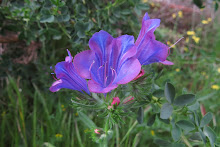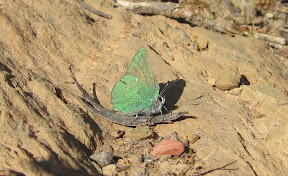
In a prior week, by Fuente Fría, on a cycling ride at dawn I could shot this video of a pair of Red-rumped swallows (Hirundo daurica, ES golondrina dáurica) gathering mud for nesting:
In Monfragüe, in early spring, I could picture the beauty of the Blue rock thrush (Monticola solitarius, ES roquero solitario),

and the surprisingly conspicuous, this time for a change, Eagle owl (Bubo bubo, ES búho real). The picture was taken by the camera I bought in December, the Canon SX50, and people watching the owl, vultures and the Spanish imperial eagle were surprised at the result. If you have been to Monfragüe, you know how far the birds can be up in the cliff of the viewpoint of La Portilla del Tíetar. Well, this is not a closeúp picture of this magnificent bird, yet it is, as always, a free raptor in its natural environment, yet caught without any digiscoping devices, just a bridge camera. Needless to say how happy and proud I was of the picture.

Here is also a picture taken in Monfragüe of the black stork (Ciconia nigra, ES cigüeña negra) in flight over the Mirador de la Tajadilla viewpoint

Below, some Rock doves (Columba livia, ES paloma bravía) are feeding in the urban newly recovered green corridor that runs along the Ribera del Marco, in Caceres town, a constant stream surrounded by vegetation.

The resources, vegetation and water, of the Ribera, gave birth, in prehistoric times, to the first settlements in the area. So, after all, Cáceres is not without its river - small though it may be. According to expert geologists and historians, the stream is extremely resilient. It does not stop flowing even when the rivers Guadiloba – to which the Ribera is a tributary, Almonte and even the mighty Tagus (ES Tajo, into which flows the Almonte) stop flowing after several years of draught that may happen now and again. This can be seen in the Almonte - one of the few if not the only one is Spain without a dam, for the rest are already pooled by dams and those stops in their flowing cannot be ascertained any more.
 (Own work based on an image of http://en.wikipedia.org/wiki/File:SpainTajoBasin.png (Creative Commons Attribution Share Alike 3.0)
(Own work based on an image of http://en.wikipedia.org/wiki/File:SpainTajoBasin.png (Creative Commons Attribution Share Alike 3.0)
This resilience and the reason for a settlement that over the millenia has grown into a town even though on a site that is normally considered a dry steppe was possible thanks to an aquifer called El Calerizo, situated in the south of the city, that feeds the stream and gets replenished when the rain returns. It it this aquifer that steadily feeds the stream. The mud of its banks is the one that was being picked up by the Red-swallows above. The Rock doves above were about here and there in short flights by the green path going along the stream up south from the old town and the Fuente Fría site (a five-minute walk from the Plaza de San Mateo, the highest square in the old town of Cáceres, a world heritage site as you may know). If you want to see some pics and videos of what you could watch from this area, clik here on the link to a blog in Spanish about the topic.
There you will have a link to this video of Kingfisher (Alcedo Atthis, ES martin pescador) bathing in the waters of the stream of La Ribera, by Fuente Fría, where it had its breeding hole las Spring:



































